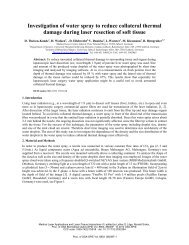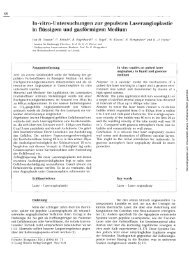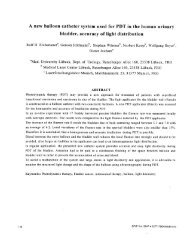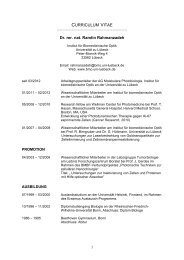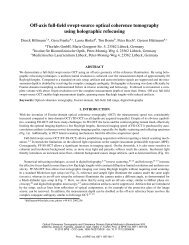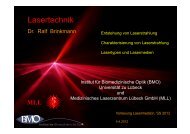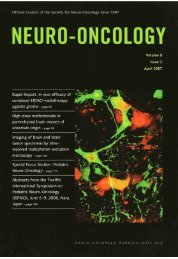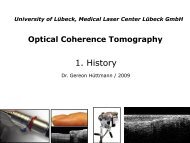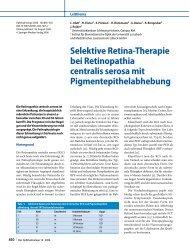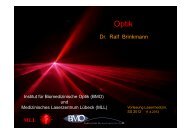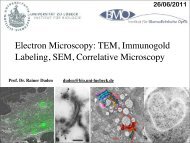Invited p aper Mechanisms of femtosecond laser nanosurgery of ...
Invited p aper Mechanisms of femtosecond laser nanosurgery of ...
Invited p aper Mechanisms of femtosecond laser nanosurgery of ...
You also want an ePaper? Increase the reach of your titles
YUMPU automatically turns print PDFs into web optimized ePapers that Google loves.
VOGEL et al. <strong>Mechanisms</strong> <strong>of</strong> <strong>femtosecond</strong> <strong>laser</strong> <strong>nanosurgery</strong> <strong>of</strong> cells and tissues 1037FIGURE 19 Radius–time curve <strong>of</strong> the cavitation bubble produced by a single <strong>femtosecond</strong> <strong>laser</strong> pulse focused at NA = 1.3 that leads to a peak temperature<strong>of</strong> T max = 200 ◦ C at the focus center. The radius <strong>of</strong> the bubble nucleus is R 0 = 91.1 nm. The temperature at the wall <strong>of</strong> the nucleus is T wall = 145 ◦ C, and themean temperature averaged over all volume elements within the bubble nucleus is T mean = 168 ◦ C. The R(t) curve in (a) was calculated under the assumptionthat the vapor pressure within the bubble is given by the mean temperature within the nucleus and decays due to heat diffusion (case 1, see text). The curve in(b) was calculated assuming that the vapor pressure drops adiabatically during bubble expansion (case 2)FIGURE 20 Maximum bubble radii for cases 1 and 2 as a function <strong>of</strong> themaximum temperature achieved in the center <strong>of</strong> the focal volume, togetherwith the radius <strong>of</strong> the nucleus, R 0staining <strong>of</strong> non-viable cells by ethidium bromide confirmedthat cell death was associated with membrane damage. Accordingto Neumann and Brinkmann [192], a bubble radius <strong>of</strong>3 µm within a cell <strong>of</strong> 7.5-µm radius is sufficient to cause anenlargement <strong>of</strong> the membrane by 4% that will result in membranerupture [193]. The results <strong>of</strong> our calculations in Fig. 20demonstrate that the radius <strong>of</strong> fs-<strong>laser</strong>-produced transient bubblesremains well below this damage threshold. This applieseven for <strong>laser</strong> pulse energies <strong>of</strong> a few nanojoules because forϱ cr = 10 21 cm −3 and 1-µm plasma length about 99% <strong>of</strong> theincident energy is transmitted through the focal region [81].The heated volume is much smaller than the volume <strong>of</strong> themicroparticles investigated by Lin et al. [189], and the depositedheat energy corresponding to a peak temperature <strong>of</strong>T max = 200 ◦ C or 300 ◦ C is only 16.6 or 25.8pJ, respectively,much less than in Lin’s case.Bubbles around gold nanoparticles are <strong>of</strong> interest in thecontext <strong>of</strong> nanoparticle cell surgery (Sect. 1.1). When particleswith 4.5-nm radius were irradiated by 400-nm, 50-fspulses, bubbles <strong>of</strong> up to 20-nm radius were observed by means<strong>of</strong> X-ray scattering techniques [194]. The small size <strong>of</strong> thesebubbles, which is one order <strong>of</strong> magnitude less than for thoseproduced by focused <strong>femtosecond</strong> <strong>laser</strong> pulses, is consistentwith the fact that the collective action <strong>of</strong> a large number<strong>of</strong> nanoparticles is required to produce the desired surgicaleffect.Membrane damage can also be induced by bubble oscillationsthat occur largely outside the cell [195], such as in<strong>laser</strong> optoporation [50]. Rupture (or at least poration) <strong>of</strong> thecell membrane requires strains larger than 2%–3% [193, 196].Again, no time-resolved investigations <strong>of</strong> the <strong>laser</strong>-based procedureare yet available, but cell poration and lysis induced bythe dynamics <strong>of</strong> pressure-wave-excited bubbles have alreadybeen studied [197]. These effects are <strong>of</strong> interest in the context<strong>of</strong> transient membrane permeabilization <strong>of</strong> cells for thetransfer <strong>of</strong> genes or other substances.So far, we have only discussed the transient bubbles producedby single <strong>laser</strong> pulses. These bubbles can only be detectedby very fast measurement schemes. However, duringhigh-repetition-rate pulse series accumulative thermal effectsand chemical dissociation <strong>of</strong> biomolecules come into play(Sects. 4 and 5.2) that can produce long-lasting bubbles thatare easily observable under the microscope [86, 88, 89]. Dissociation<strong>of</strong> biomolecules may provide inhomogeneous nucleithat lower the bubble-formation threshold below the superheatlimit defined by the kinetic spinodal. Even thoughthermoelastic forces may still support the bubble growth, itis mainly driven by boiling <strong>of</strong> cell water and by chemicalor thermal decomposition <strong>of</strong> biomolecules into small volatilefragments. After the end <strong>of</strong> the fs pulse train, the vapor willrapidly condense but the volatile decomposition products willdisappear only by dissolution into the surrounding liquid andthus form a longer-lasting bubble.Long-lasting ‘residual’ bubbles have also been observedafter pulse series <strong>of</strong> 3.8-kHz repetition rate where, accordingto our results Sect. 5.2, accumulative thermal effects canbe excluded, but they were seen only when fairly large pulseenergies <strong>of</strong> ≥ 180 nJ were applied [198]. The experimentswere performed using a numerical <strong>aper</strong>ture <strong>of</strong> NA = 0.6.Ourtemperature calculations revealed that, at this NA, the energyrequired to produce any specific temperature rise is 22.7 times



